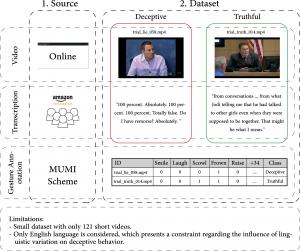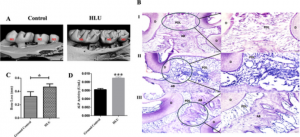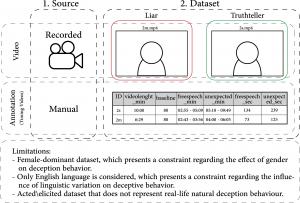Machine learning methods are best suited to catch liars, according to the new science of deception detection

The study analyzed 121 short videos as part of a small dataset to distinguish between truthful and deceptive conversations. Credit: Expert Systems with Applications (2025). DOI: https://doi.org/10.1016/j.eswa.2025.127601

The research examined a dataset covering two hours of footage to measure the influence of linguistic variation. Credit: Expert Systems with Applications (2025). DOI: https://doi.org/10.1016/j.eswa.2025.127601
Detecting lies has always challenged scientists and authorities, but AI-based lie detection devices may have the potential to rise to the challenge.
SHARJAH, EMIRATE OF SHARJAH, UNITED ARAB EMIRATES, June 26, 2025 /EINPresswire.com/ -- Scientists have revealed that Convolutional Neural Networks (CNNs), a type of deep learning algorithm, demonstrate superior performance compared to conventional non-machine learning approaches when used to detect lies and deception.
They demonstrate that AI and machine learning-based methods have the potential to provide accurate predictions if they overcome one major limitation – their current inability to account for cultural, linguistic, and gender differences among various societies and populations.
The researchers, based at the University of Sharjah in the United Arab Emirates, have reported their findings in a recent review paper published in the journal Expert Systems with Applications, in which they present an analysis of deception detection techniques leveraging machine learning. (https://doi.org/10.1016/j.eswa.2025.127601)
Their findings follow a comprehensive literature search of various databases like Google Scholar, Elsevier, ACM Digital Library, IEE Xplore, and Springer, using the keyword “deception detection”.
The research papers selected for analysis were published between 2012 and 2023. The authors aimed to extract knowledge from existing literature on deception detection and streamline methods to detect lies via machine learning, and compare them to conventional non-machine learning approaches.
“Our objective was to conduct a comprehensive review of publications focusing on the computational prediction of deception, particularly using ML (Machine Learning) approaches. For a paper to be included in our analysis, it had to employ an ML-based approach to identify deception, utilize datasets, and be written in English,” the scientists write.
“Through our meta-analysis, we identified a total of 98 published papers that met our criteria. The earliest document in our analysis dates back to 2012, while the most recent publication was in 2023. Notably, approximately half of these papers were published in 2019 or later.
“While there are systematic review papers related to AI-based deception detection, we conducted a comprehensive analysis on deception detection, providing a clear overview of the field contributions and limitations.”
Deception detection research has recently garnered considerable attention, as scientists believe that studying lies and the reasons why people resort to deception can lead to a more objective understanding of human behavior.
They note that deception and lies are used interchangeably in the literature, which categorizes deceptive behavior into various types based on its implications, ranging from being harmful to having serious consequences.
The authors' extensive review shows that lies are common in everyday life, and even people who claim to be honest “occasionally engage in deception, where the average person lies multiple times a day.”
Lies, the authors point out, can range from outright deception, “I did not kill him!” to harmless white lies, “That outfit looks nice,” used to avoid embarrassing and awkward situations.
The authors glean from their review that lies are found to be the biggest challenge facing the legal system. “Mistaking lies for the truth, or vice versa, in such situations can have significant repercussions for the individuals involved and society at large,” they note.
The study of deception and lies, they add, has long been a topic of interest for researchers concerned about their adverse consequences in clinical, ethical, and legal spheres. The body of the literature selected for the study, according to the authors, utilizes “various data collection methods, data types, and techniques …, revealing differences in verbal and nonverbal cues between lies and truths.”
The authors’ review highlights how deception research also relies on body signals, which they refer to as “physiological cues,” that scientists have used to distinguish between deceptive and truthful actions and utterances, such as pupil size, eye movement, hand position, heart rate, and what people write or say.
The plethora of deception research and lies is voluminous, the scientists emphasize. Their extensive review covers all aspects of previous traditional methods for detecting deception, including the most commonly used instruments to find out whether an individual was telling the truth, such as polygraphs.
The literature, they add, has relied on a variety of databases, “typically consisting of short statements, online articles, information disorder, interviews, and auxiliary indicators such as Electroencephalography (EEG) attributes, annotations, and transcriptions.”
The authors, while lauding traditional methods to detect deception, stress the role of recent studies using AI and machine learning, which have made catching liars and false instances more effective than before.
The science of catching liars and detecting deception, the authors show, is leaning more and more on AI and machine learning, which can analyze and interpret different types of data, demonstrating a potential to accurately identify falsehoods, lies, and deceptions even within the realm of involuntary and fleeting facial expressions, and short language utterances whether spoken or written.
The study is not confined to a literature review. The scientists triangulate their research across multiple datasets to measure the effect of gender on deception behavior. They analyze 35 short videos to determine the influence of linguistic variation on deceptive behavior, in addition to a dataset covering two hours of footage to gauge the impact of linguistic and cultural variations in distinguishing between truthful and deceptive conversations.
The authors find that machine learning-driven approaches, when compared with the performance of traditional methods, achieve improved efficiency in spotting lies and deceptive actions or statements.
However, they identify certain limitations that hitherto hinder AI-based deception detection methods from achieving exact accuracy. One major limitation and gap in deception detection research, according to them, is the failure of machine learning devices to account for the role of culture, language, and gender and how they could limit “the generalizability of the findings to diverse populations.”
LEON BARKHO
University Of Sharjah
+971 50 165 4376
email us here
Legal Disclaimer:
EIN Presswire provides this news content "as is" without warranty of any kind. We do not accept any responsibility or liability for the accuracy, content, images, videos, licenses, completeness, legality, or reliability of the information contained in this article. If you have any complaints or copyright issues related to this article, kindly contact the author above.


